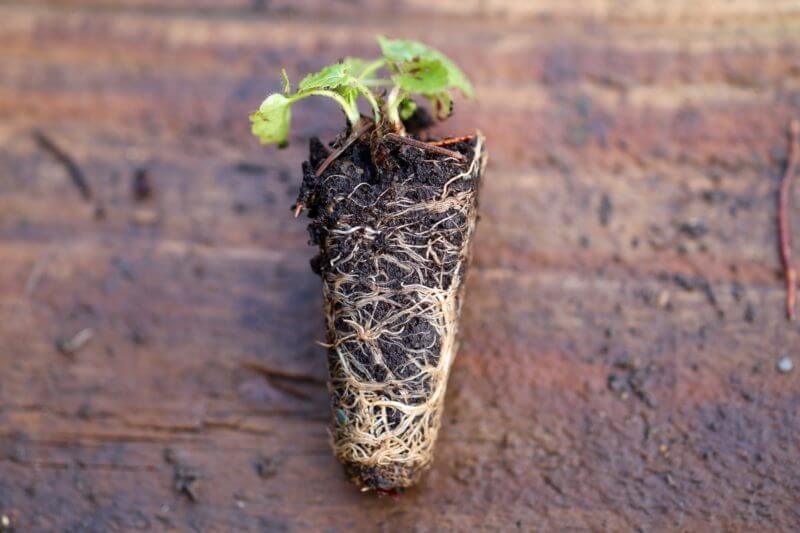A plant plug is a young seedling that was started and grown in an individual cell or container filled with potting soil. Plant plugs provide a convenient and cost-effective way to get a head start on growing vegetables, herbs, flowers and other plants.
What Exactly is a Plug?
A plug refers specifically to a seedling grown in its own individual cell or container rather than sown directly into the ground or a larger shared pot. The plug consists of the plant itself along with the soil surrounding its roots inside the cell.
Plug trays typically contain many interconnected cells, allowing you to start a large number of seedlings together in a small space. The individual cells provide each seedling with enough room for its roots to establish during the initial growth period.
Once the plugs have developed strong root systems and some leaves they can be transplanted into larger containers or directly into garden beds. Using plugs eliminates the need to start seeds directly in the garden and wait for germination. It gives the plants a head start on growth before being moved to their permanent location.
Benefits of Using Plugs
There are several advantages to using plugs rather than sowing seeds directly
-
Earlier harvesting – Plugs get a head start on growth indoors or in a greenhouse, allowing earlier transplanting and harvesting of crops.
-
Higher germination rates – Seeds germinate more successfully in the ideal controlled conditions provided by plug trays.
-
Less wasted seeds – With direct sowing, many seeds fail to germinate or seedlings die off. Plugs allow you to first establish strong seedlings before putting them in the ground.
-
Easier spacing – Plugs can be precisely spaced when transplanted, while seeds may germinate too close together or leave gaps.
-
Less weeding – Established plugs are better able to outcompete weeds after transplanting.
-
Wider variety – Plugs enable you to grow many more varieties in a small space compared to direct sowing.
-
Convenience – Plugs are clean and easy to handle compared to loose seeds.
How to Grow Plugs Successfully
Follow these tips for the best results when growing plant plugs:
Select Plug Trays
Plug trays come in many different cell sizes and configurations. Smaller cells like those holding 1-2 inch plugs are good for starting seeds. Larger 3-4 inch plugs give transplants more room to develop before planting. Look for trays with drainage holes in the bottom of each cell. Self-watering trays that provide water from below are excellent for maintaining consistent moisture.
Use a Seed Starting Mix
Plug trays require a lightweight, well-draining seed starting mix. These mixes are soilless, containing peat moss, vermiculite or perlite. Do not use regular potting soil which can compact and get waterlogged. Moisten the starting mix before filling cells, then plant 1-2 seeds per cell and cover lightly with mix.
Provide Warmth for Germination
Seeds need sufficient warmth to germinate, usually 65-75°F. Use a heat mat under the plug tray or keep it in a warm greenhouse. Once sprouted, move to an area with temperatures around 60-70°F to avoid leggy growth. Provide ample light from grow lights or indirect sunlight.
Maintain Even Moisture
Check plugs daily and water when the starting mix begins to dry out on top. Water gently to avoid dislodging seeds. Uneven moisture causes seeds to rot or seedlings to damp off. Self-watering trays prevent drying out but avoid overwatering. Allow good drainage.
Wait to Fertilize
Seedlings in plugs get nutrients from the starting mix and stored energy in the seed itself. Avoid fertilizing until the first true leaves emerge. Then use a diluted liquid fertilizer like fish emulsion once a week. Excess nutrients can damage tender young plants.
Harden Off Before Transplanting
A week before transplanting plugs outside, begin the hardening off process. This transitions the plants from indoor to outdoor conditions. Set them in a sheltered spot outdoors for a few hours, gradually increasing time over the week. Protect from direct sun and wind which can shock tender plants. Avoid transplanting before the last spring frost date.
Transplant Carefully
When transplanting plugs, handle them gently by the leaves or root ball, not the stem. Make holes the same depth as the plug. Gently loosen and spread out any roots that have escaped the plug before placing it in the hole. Firm the soil around the base without compacting it and water well. Keep newly planted plugs well-watered until established.
Ideal Plants for Plug Growing
While almost any garden plant can be started as a plug, some types are especially well-suited:
- Vegetable transplants – tomatoes, peppers, broccoli, cabbage, lettuce
- Herbs – basil, thyme, oregano, mint, cilantro
- Flowers – marigolds, zinnias, cosmos, snapdragons, petunias
- Fruits – strawberries, blueberries, raspberries, blackberries
The convenience of plugs makes them a great way to add a variety of plants to both flower and vegetable gardens. Follow proper growing methods for thriving transplants that establish quickly after planting.
Growing from plug plants? What are plug plants? It’s time to talk about plug plants.
FAQ
What is the difference between a plug and a seedling?
What is a starter plant plug?
How do you take care of plant plugs?
How to use grow plugs?
- A Complete Guide to Caring for Yuki Cherry Blossom Shrub - January 23, 2025
- Identifying Red Hot Poker Seeds: What to Look For When Harvesting Torch Lily Pods - January 23, 2025
- A Complete Guide to Harvesting Evening Primrose Seeds - January 23, 2025

